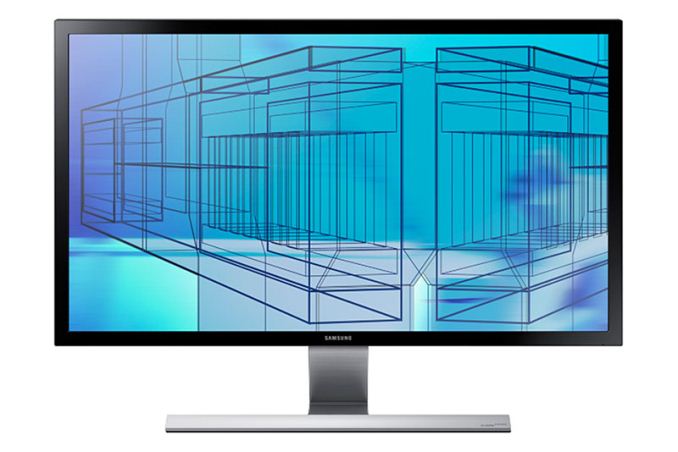AMD Announces Upcoming Samsung FreeSync Displays
by Jarred Walton on November 20, 2014 4:31 PM EST
Today at AMD's Future of Compute event in Singapore, AMD announced partnerships with several companies. One of the more noteworthy announcements is that Samsung will be making FreeSync enabled displays that should be available in March 2015. The displays consist of the 23.6" and 28" UD590, and there will be 23.6", 28", and 31.5" variants of the UE850. These are all UHD (4K) displays, and Samsung has stated their intention to support Adaptive-Sync (and thereby FreeSync) on all of their UHD displays in the future.
FreeSync is AMD's alternative to NVIDIA's G-SYNC, with a few key differences. The biggest difference is that AMD proposed an extension to DisplayPort called Adaptive-Sync, and the VESA group accepted this extension as an amendment to the DisplayPort 1.2a specifications. Adaptive-Sync is thus an open standard that FreeSync leverages to enable variable refresh rates. As far as system requirements for FreeSync, other than a display that supports DisplayPort Adaptive-Sync, you need a supported AMD GPU with a DisplayPort connection and a driver from AMD with FreeSync support.
FreeSync is also royalty free, which should help manufacturers in controlling costs on FreeSync capable displays. There are other costs to creating a display that can support Adaptive-Sync, naturally, so we wouldn't expect price parity with existing LCDs in the near term. On the FreeSync FAQ, AMD notes that the manufacturing and validation requirements to support variable refresh rates without visual artifacts are higher than traditional LCDs, and thus cost-sensitive markets will likely hold off on adopting the standard for now. Over time, however, if Adaptive-Sync catches on then economies of scale come into play and we could see widespread adoption.
Being an open standard does have its drawbacks. NVIDIA was able to partner up with companies and develop G-SYNC and deploy it about a year ago, and there are now 4K 60Hz G-SYNC displays (Acer's XB280HK) and QHD 144Hz G-SYNC display (ASUS' ROG Swift PG278Q) that have been shipping for several months. In many ways G-SYNC showed the viability of adaptive refresh rates, but regardless of who gets credit the technology is quite exciting. If Adaptive-Sync does gain traction, as an open standard there's nothing to stop NVIDIA from supporting the technology and altering G-SYNC to work with Adaptive-Sync displays, but we'll have to wait and see on that front.
Pricing for the Samsung displays has not been announced, though the existing UD590 models tend to cost around $600 for the 28" version. I'd expect the Adaptive-Sync enabled monitors to have at least a moderate price premium, but we'll see when they become available some time around March 2015.
Source: AMD










73 Comments
View All Comments
eastyy123 - Thursday, November 20, 2014 - link
the price for g-sync i think is to much and i really thought there would have been a lot more choice of monitors with g-sync by nowEdgeOfDetroit - Thursday, November 20, 2014 - link
What I want is a 21:9 aspect ratio monitor with G-Sync support, a high refresh rate (120 or 144 Hz), and low latency (gamer focused). I don't want to run a triple-monitor setup, bezels are bad. Anything incoming like this?MartinT - Friday, November 21, 2014 - link
Problem is you need the angle-independent colours of IPS or VA displays for good image quality in 21:9, and those aren't known to do more than 60 Hz.Hrel - Friday, November 21, 2014 - link
IPS also isn't low latency.meacupla - Friday, November 21, 2014 - link
PLS and IPS can do 120Hz, as already proven by the numerous cheap korean 1440/1600p screens on the market.The only limitation seems to be the controller chip on the monitor and brightness degradation at high refresh rates.
Morawka - Friday, November 21, 2014 - link
PLS can, IPS cannot. PLS is a poor man's "IPS" and does not always match performance.MrSpadge - Friday, November 21, 2014 - link
I'd be interested in GSync with a 21:9 xPS or xVA (anything not TN, basically) at 60 Hz. Give it a decent PPI of ~130, so I might get away without scaling.chizow - Thursday, November 20, 2014 - link
G-Sync carries about $200 premium, we already know how much these Samsung models cost ($600 for non-ASync), how much do you think they will cost with ASync? Pretty good chance it won't be "Free"Sync anyways.As a comparison, the Acer G-Sync 4K display and the Asus Swift 144Hz 1440p G-Sync display cost $800. Not a whole lot of wiggle room left for any significant ASync discount given AMD estimates their version will be around $100 cheaper than G-Sync.
In any case, it will most likely come to quality and support of the solution. Having used G-Sync already for 4 months, it is a seamless experience in single-GPU mode and well worth the investment whether you are an AMD or Nvidia user.
Flunk - Thursday, November 20, 2014 - link
There is a big cost different. Adaptive VSync is royalty-free technology that's part of the DisplayPort standard, G-Sync requires the monitor manufacturer include Nvidia hardware into the monitor design. I don't think it will be long before every monitor supports adaptive vsync, it really is that cheap to implement. Nvidia will have to give in eventually and eventually will probably be sooner than later.I personally don't care which technology wins because both technologies are basically interchangeable, but I do know that whichever is easiest for the industry will win. Even Intel gave in to the easier to implement technology. Remember IA86? No, well that's because we're all using AMD's AMD64 technology for our 64bit x86 processors now.
Flunk - Thursday, November 20, 2014 - link
IA86 => IA64, too many stupid acronyms.